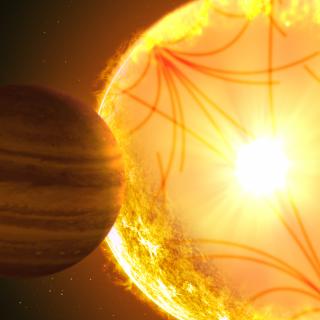Bibcode
Swayne, M. I.; Maxted, P. F. L.; Triaud, A. H. M. J.; Sousa, S. G.; Deline, A.; Ehrenreich, D.; Hoyer, S.; Olofsson, G.; Boisse, I.; Duck, A.; Gill, S.; Martin, D.; McCormac, J.; Persson, C. M.; Santerne, A.; Sebastian, D.; Standing, M. R.; Acuña, L.; Alibert, Y.; Alonso, R.; Anglada, G.; Bárczy, T.; Barrado Navascues, D.; Barros, S. C. C.; Baumjohann, W.; Baycroft, T. A.; Beck, M.; Beck, T.; Benz, W.; Billot, N.; Bonfils, X.; Borsato, L.; Bourrier, V.; Brandeker, A.; Broeg, C.; Carmona, A.; Charnoz, S.; Collier Cameron, A.; Cortés-Zuleta, P.; Csizmadia, Sz; Cubillos, P. E.; Davies, M. B.; Deleuil, M.; Delfosse, X.; Delrez, L.; Demangeon, O. D. S.; Demory, B. -O.; Dransfield, G.; Erikson, A.; Fortier, A.; Forveille, T.; Fossati, L.; Fridlund, M.; Gandolfi, D.; Gillon, M.; Güdel, M.; Günther, M. N.; Hara, N.; Hébrard, G.; Heidari, N.; Hellier, C.; Helling, Ch; Isaak, K. G.; Kerschbaum, F.; Kiefer, F.; Kiss, L. L.; Kunovac, V.; Lalitha, S.; Lam, K. W. F.; Laskar, J.; Lecavelier des Etangs, A.; Lendl, M.; Magrin, D.; Marafatto, L.; Martioli, E.; Miller, N. J.; Mordasini, C.; Moutou, C.; Nascimbeni, V.; Ottensamer, R.; Pagano, I.; Pallé, E.; Peter, G.; Piazza, D.; Piotto, G.; Pollacco, D.; Queloz, D.; Ragazzoni, R.; Rando, N.; Rauer, H.; Ribas, I.; Santos, N. C.; Scandariato, G.; Ségransan, D.; Simon, A. E.; Smith, A. M. S.; Southworth, R.; Stalport, M.; Szabó, Gy M.; Thomas, N. et al.
Referencia bibliográfica
Monthly Notices of the Royal Astronomical Society
Fecha de publicación:
3
2024
Número de citas
9
Número de citas referidas
7
Descripción
Observations of low-mass stars have frequently shown a disagreement between observed stellar radii and radii predicted by theoretical stellar structure models. This 'radius inflation' problem could have an impact on both stellar and exoplanetary science. We present the final results of our observation programme with the CHaracterising ExOPlanet Satellite (CHEOPS) to obtain high-precision light curves of eclipsing binaries with low-mass stellar companions (EBLMs). Combined with the spectroscopic orbits of the solar-type companions, we can derive the masses, radii, and effective temperatures of 23 M-dwarf stars. We use the PYCHEOPS data analysis software to analyse their primary and secondary occultations. For all but one target, we also perform analyses with Transiting Exoplanet Survey Satellite (TESS) light curves for comparison. We have assessed the impact of starspot-induced variation on our derived parameters and account for this in our radius and effective temperature uncertainties using simulated light curves. We observe trends in inflation with both metallicity and orbital separation. We also observe a strong trend in the difference between theoretical and observational effective temperatures with metallicity. There is no such trend with orbital separation. These results are not consistent with the idea that the observed inflation in stellar radius combines with lower effective temperature to preserve the luminosity predicted by low-mass stellar models. Our EBLM systems provide high-quality and homogeneous measurements that can be used in further studies of radius inflation.
Proyectos relacionados

Sismología Solar y Estelar y Búsqueda de Exoplanetas
Los objetivos genéricos de este Proyecto son: 1) el estudio de la estructura y dinámica del interior solar, 2) la extensión de dicho estudio al caso de otras estrellas, 3) la búsqueda y caracterización de planetas extrasolares por métodos fotométricos (principalmente mediante el método de tránsitos) y espectroscópico (variaciones en la velocidad
Savita
Mathur

Exoplanetas y Astrobiología
La búsqueda de vida en el Universo se ha visto impulsada por los recientes descubrimientos de planetas alrededor de otras estrellas (los llamados exoplanetas), convirtiéndose en uno de los campos más activos dentro de la Astrofísica moderna. En los últimos años los descubrimientos cada vez más numerosos de nuevos exoplanetas y los últimos avances
Enric
Pallé Bago